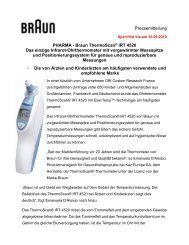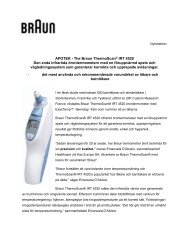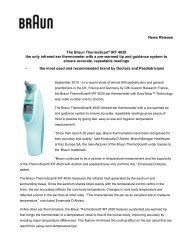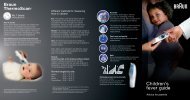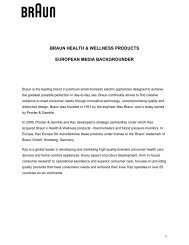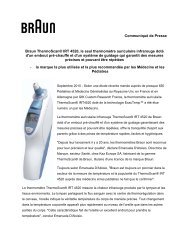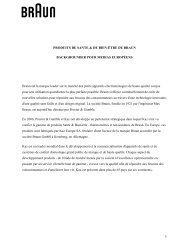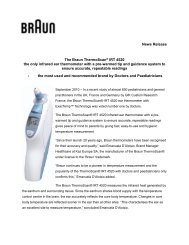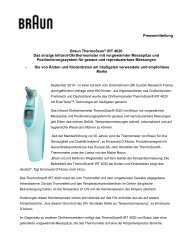Vicks Media Backgrounder EN - Kaz Europe SA
Vicks Media Backgrounder EN - Kaz Europe SA
Vicks Media Backgrounder EN - Kaz Europe SA
Create successful ePaper yourself
Turn your PDF publications into a flip-book with our unique Google optimized e-Paper software.
KAZ S.A.’S GUIDE TO FEVER AND THERMOMETERS<br />
1. What is Fever?<br />
If body temperature is consistently above normal temperature range, the patient is said to have a<br />
fever. Fevers are a defence mechanism the body uses to fight infections and are therefore<br />
frequently associated with illnesses. Yet fevers alone are not an illness, only a symptom.<br />
Babies and young children commonly have up to 12 infections per year, and on average seven of<br />
these cause a fever. Many of them are harmless, such as a sore throat or a cold. But they can be<br />
more dangerous, including acute ear infections, or even life-threatening, like meningitis. On<br />
average, school-age children have around three febrile infections per year and adults two.<br />
2. Temperature measurement<br />
Temperatures are taken most commonly in the ear (tympanic measurement), in the mouth (orally<br />
measurement), under the arm (auxiliary measurement) or in the bottom (rectally measurement).<br />
Each method is considered accurate when done correctly. Except for ear thermometers, most<br />
digital thermometers are universal, meaning temperature can be taken orally, rectally or under<br />
the arm. Temperature readings can differ slightly depending on the method, so be sure to use the<br />
same method for the sake of consistency.<br />
• Ear<br />
Ear measurements are gentle, easy and fast, and thus preferred by many parents. However, the<br />
temperature often varies between readings, leading to the misconception that ear thermometers<br />
are inaccurate. To minimise this effect, it’s very important to use the correct ear thermometer. A<br />
reading of 38°C or higher is generally considered as fever.<br />
• Oral<br />
Oral temperature taking is generally recommended for children who are at least four years of age<br />
and can easily hold the thermometer in their mouth. A reading of 37.5°C or higher is generally<br />
considered a fever.<br />
• Underarm<br />
This is a safe and straightforward method for children of all ages. A reading of 37°C or higher is<br />
generally considered as fever.<br />
• Rectal<br />
Taking a baby’s rectal temperature is not difficult and does not have to be uncomfortable for<br />
either the baby or the parent. There are some thermometers designed especially for rectal<br />
measurements that make it fast and easy. A reading of 38°C or higher is generally considered a<br />
fever.<br />
4



